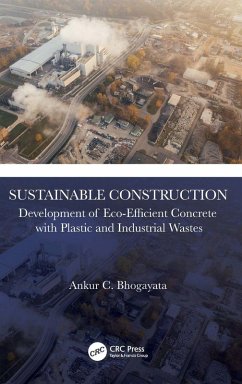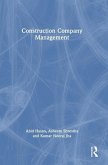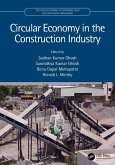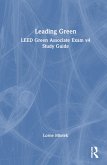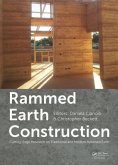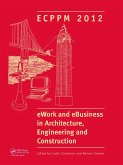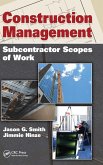Ankur C Bhogayata
Sustainable Construction
Development of Eco-Efficient Concrete with Plastic and Industrial Wastes
Ankur C Bhogayata
Sustainable Construction
Development of Eco-Efficient Concrete with Plastic and Industrial Wastes
- Gebundenes Buch
- Merkliste
- Auf die Merkliste
- Bewerten Bewerten
- Teilen
- Produkt teilen
- Produkterinnerung
- Produkterinnerung
This book focuses on the utilization of the wastes produced from plastic usage by industry and consumers along with the partial to full replacement of conventional cement as a primary binder material in concrete. The primary aim is to show the methods to prepare a sustainable construction alternative material of concrete using waste materials.
Andere Kunden interessierten sich auch für
![3D Printing for Construction in the Transformation of the Building Industry 3D Printing for Construction in the Transformation of the Building Industry]() 3D Printing for Construction in the Transformation of the Building Industry171,99 €
3D Printing for Construction in the Transformation of the Building Industry171,99 €![Construction Company Management Construction Company Management]() Abid HasanConstruction Company Management206,99 €
Abid HasanConstruction Company Management206,99 €![Circular Economy in the Construction Industry Circular Economy in the Construction Industry]() Circular Economy in the Construction Industry180,99 €
Circular Economy in the Construction Industry180,99 €![Leadinggreen Leadinggreen]() Lorne MlotekLeadinggreen182,99 €
Lorne MlotekLeadinggreen182,99 €![Rammed Earth Construction Rammed Earth Construction]() Rammed Earth Construction179,99 €
Rammed Earth Construction179,99 €![Ework and Ebusiness in Architecture, Engineering and Construction Ework and Ebusiness in Architecture, Engineering and Construction]() Ework and Ebusiness in Architecture, Engineering and Construction537,99 €
Ework and Ebusiness in Architecture, Engineering and Construction537,99 €![Construction Management Construction Management]() Jason G SmithConstruction Management261,99 €
Jason G SmithConstruction Management261,99 €-
-
-
This book focuses on the utilization of the wastes produced from plastic usage by industry and consumers along with the partial to full replacement of conventional cement as a primary binder material in concrete. The primary aim is to show the methods to prepare a sustainable construction alternative material of concrete using waste materials.
Hinweis: Dieser Artikel kann nur an eine deutsche Lieferadresse ausgeliefert werden.
Hinweis: Dieser Artikel kann nur an eine deutsche Lieferadresse ausgeliefert werden.
Produktdetails
- Produktdetails
- Verlag: CRC Press
- Seitenzahl: 194
- Erscheinungstermin: 4. Dezember 2023
- Englisch
- Abmessung: 234mm x 156mm x 13mm
- Gewicht: 472g
- ISBN-13: 9781032527956
- ISBN-10: 1032527951
- Artikelnr.: 68714959
- Herstellerkennzeichnung
- Libri GmbH
- Europaallee 1
- 36244 Bad Hersfeld
- gpsr@libri.de
- Verlag: CRC Press
- Seitenzahl: 194
- Erscheinungstermin: 4. Dezember 2023
- Englisch
- Abmessung: 234mm x 156mm x 13mm
- Gewicht: 472g
- ISBN-13: 9781032527956
- ISBN-10: 1032527951
- Artikelnr.: 68714959
- Herstellerkennzeichnung
- Libri GmbH
- Europaallee 1
- 36244 Bad Hersfeld
- gpsr@libri.de
Ankur C. Bhogayata is a Professor in the Department of Civil Engineering, Marwadi University, Rajkot, Gujarat, India. He has 20 years of work experience including teaching and research activities. He obtained his PhD from Saurashtra University in Civil Engineering with specialization in Concrete Technology. He has been granted with one patent and three design patents by the Intellectual Property Rights, Patent Office of Government of India. He has published more than 16 research articles in SCI and SCOPUS index journals with reputed publishers such as Elsevier, Springer, and ACI journals and has earned 11 h-index and 11 i10-index with more than 431 citations. His areas of expertise include concrete composites, geopolymer concrete, precast concrete, application of AI-based optimization methods for mix design of concrete, sustainable concrete, use of nano-particles in concrete, and study of structures exposed to marine environments. Presently, more than six research scholars are pursuing PhD under his supervision and one student obtained his PhD in the academic year 2021. He is the recognized reviewer for reputed journals also. He has been awarded with IGIP recognition by the International Society of Engineering Pedagogy, Austria, for his innovative teaching-learning practices for the students in Architecture and Civil Engineering programs. He has supervised more than 24 Master's degree students for thesis and also guided several undergraduate students for their research projects in the field of concrete technology. He has received funded projects from SSIP, NewGen IEDC, and GUJCOST for research work and academic activities. Music, painting, and reading are his hobbies. He is a member of the Institution of Engineers India, ISTE, and a life member of the India Chapter of American Concrete Institute.
Chapter 1 Introduction
1.1 Need for the Development of Eco-Efficient Concrete
1.2 Recent Trends of Research in the Development of Eco-Efficient Concrete
1.3 Summary of Significant Outcomes and Areas for Research Improvement
References
Chapter 2 Plastic Wastes
2.1 Types of Plastics and Their Usages for Consumer-Oriented Activities
2.2 Trends of Waste Generation and Their Hazardous Impacts
2.3 Feasibility of Plastic Waste Types for Addition in Concrete Composite
Chapter 3 Industrial Wastes
3.1 Types of Industrial Wastes
3.2 A Scenario of Generation and Utilization
3.3 Feasibility of Industrial Waste Utilization in Concrete Composites
Chapter 4 Development of Concrete Composite Using Plastic and Industrial
Wastes
4.1 Properties of Waste Plastics Useful for Concrete Manufacturing
4.2 Properties of Industrial Wastes in Concrete Manufacturing
4.3 Pilot Studies and Preliminary Experimental Evaluation of Modified
Concrete
4.4 Significance of Addition of Waste in Conventional Concrete
4.5 Potential of Modified Concrete for Detailed Evaluation
References
Chapter 5 Material Properties of Concrete Containing Plastic Wastes
5.1 Mix Design of the Concrete Modified with Plastic Wastes
5.2 Methods of Preparing Concrete with Plastic Wastes
5.3 Fresh Properties
5.4 Mechanical Properties
5.5 Durability Properties
5.6 Structural Performance of Members Prepared with a Modified Concrete
5.7 Special Remarks on the Use of Plastic Wastes in Concrete
References
Chapter 6 Material Properties of Concrete Prepared with Industrial Wastes
6.1 Mix Design of the Concrete
6.2 Methods of Manufacturing
6.3 Curing Requirements
6.4 Fresh Properties
6.5 Mechanical Properties
6.6 Durability Properties
6.7 Structural Performance of Members Prepared with Modified Concrete
6.8 Special Remarks on the Use of Different Industrial Wastes in Concrete
Chapter 7 Evaluation of the Concrete Blended with Industrial and Plastic
Wastes
7.1 Fresh and Mechanical Properties
7.2 Durability Properties
7.3 Influence of Plastic Wastes on the Performance of Concrete Composite
7.4 Influence of Industrial Wastes on the Performance of Concrete Composite
7.5 Summary of Assessment of Modified Concrete
Chapter 8 Applications of Modified Concrete in the Civil Engineering Fields
8.1 Utilization of the Modified Concrete in Non-structural Applications
8.2 Utilization of the Modified Concrete in Structural Applications
8.3 Utilization of the Modified Concrete in Pre-cast Concrete Manufacturing
8.4 Utilization of the Modified Concrete in Asphalt-Based Concrete
8.5 References of the National and International Codes of Practices
References
Chapter 9 Life Cycle Assessment and Economic Advantages of Modified
Concretes
9.1 LCA of Conventional Concrete
9.2 LCA of Concrete Containing Plastic Wastes
9.3 LCA of Concrete Containing Industrial Wastes
9.4 Economical Aspects, Cost Comparison, and Logistics of Modified Concrete
Chapter 10 Future Research Areas in the Topic and Suggested Readings
10.1 Future Research Topics in the Area of Development of Sustainable
Concrete
10.2 Suggested Reading
1.1 Need for the Development of Eco-Efficient Concrete
1.2 Recent Trends of Research in the Development of Eco-Efficient Concrete
1.3 Summary of Significant Outcomes and Areas for Research Improvement
References
Chapter 2 Plastic Wastes
2.1 Types of Plastics and Their Usages for Consumer-Oriented Activities
2.2 Trends of Waste Generation and Their Hazardous Impacts
2.3 Feasibility of Plastic Waste Types for Addition in Concrete Composite
Chapter 3 Industrial Wastes
3.1 Types of Industrial Wastes
3.2 A Scenario of Generation and Utilization
3.3 Feasibility of Industrial Waste Utilization in Concrete Composites
Chapter 4 Development of Concrete Composite Using Plastic and Industrial
Wastes
4.1 Properties of Waste Plastics Useful for Concrete Manufacturing
4.2 Properties of Industrial Wastes in Concrete Manufacturing
4.3 Pilot Studies and Preliminary Experimental Evaluation of Modified
Concrete
4.4 Significance of Addition of Waste in Conventional Concrete
4.5 Potential of Modified Concrete for Detailed Evaluation
References
Chapter 5 Material Properties of Concrete Containing Plastic Wastes
5.1 Mix Design of the Concrete Modified with Plastic Wastes
5.2 Methods of Preparing Concrete with Plastic Wastes
5.3 Fresh Properties
5.4 Mechanical Properties
5.5 Durability Properties
5.6 Structural Performance of Members Prepared with a Modified Concrete
5.7 Special Remarks on the Use of Plastic Wastes in Concrete
References
Chapter 6 Material Properties of Concrete Prepared with Industrial Wastes
6.1 Mix Design of the Concrete
6.2 Methods of Manufacturing
6.3 Curing Requirements
6.4 Fresh Properties
6.5 Mechanical Properties
6.6 Durability Properties
6.7 Structural Performance of Members Prepared with Modified Concrete
6.8 Special Remarks on the Use of Different Industrial Wastes in Concrete
Chapter 7 Evaluation of the Concrete Blended with Industrial and Plastic
Wastes
7.1 Fresh and Mechanical Properties
7.2 Durability Properties
7.3 Influence of Plastic Wastes on the Performance of Concrete Composite
7.4 Influence of Industrial Wastes on the Performance of Concrete Composite
7.5 Summary of Assessment of Modified Concrete
Chapter 8 Applications of Modified Concrete in the Civil Engineering Fields
8.1 Utilization of the Modified Concrete in Non-structural Applications
8.2 Utilization of the Modified Concrete in Structural Applications
8.3 Utilization of the Modified Concrete in Pre-cast Concrete Manufacturing
8.4 Utilization of the Modified Concrete in Asphalt-Based Concrete
8.5 References of the National and International Codes of Practices
References
Chapter 9 Life Cycle Assessment and Economic Advantages of Modified
Concretes
9.1 LCA of Conventional Concrete
9.2 LCA of Concrete Containing Plastic Wastes
9.3 LCA of Concrete Containing Industrial Wastes
9.4 Economical Aspects, Cost Comparison, and Logistics of Modified Concrete
Chapter 10 Future Research Areas in the Topic and Suggested Readings
10.1 Future Research Topics in the Area of Development of Sustainable
Concrete
10.2 Suggested Reading
Chapter 1 Introduction
1.1 Need for the Development of Eco-Efficient Concrete
1.2 Recent Trends of Research in the Development of Eco-Efficient Concrete
1.3 Summary of Significant Outcomes and Areas for Research Improvement
References
Chapter 2 Plastic Wastes
2.1 Types of Plastics and Their Usages for Consumer-Oriented Activities
2.2 Trends of Waste Generation and Their Hazardous Impacts
2.3 Feasibility of Plastic Waste Types for Addition in Concrete Composite
Chapter 3 Industrial Wastes
3.1 Types of Industrial Wastes
3.2 A Scenario of Generation and Utilization
3.3 Feasibility of Industrial Waste Utilization in Concrete Composites
Chapter 4 Development of Concrete Composite Using Plastic and Industrial
Wastes
4.1 Properties of Waste Plastics Useful for Concrete Manufacturing
4.2 Properties of Industrial Wastes in Concrete Manufacturing
4.3 Pilot Studies and Preliminary Experimental Evaluation of Modified
Concrete
4.4 Significance of Addition of Waste in Conventional Concrete
4.5 Potential of Modified Concrete for Detailed Evaluation
References
Chapter 5 Material Properties of Concrete Containing Plastic Wastes
5.1 Mix Design of the Concrete Modified with Plastic Wastes
5.2 Methods of Preparing Concrete with Plastic Wastes
5.3 Fresh Properties
5.4 Mechanical Properties
5.5 Durability Properties
5.6 Structural Performance of Members Prepared with a Modified Concrete
5.7 Special Remarks on the Use of Plastic Wastes in Concrete
References
Chapter 6 Material Properties of Concrete Prepared with Industrial Wastes
6.1 Mix Design of the Concrete
6.2 Methods of Manufacturing
6.3 Curing Requirements
6.4 Fresh Properties
6.5 Mechanical Properties
6.6 Durability Properties
6.7 Structural Performance of Members Prepared with Modified Concrete
6.8 Special Remarks on the Use of Different Industrial Wastes in Concrete
Chapter 7 Evaluation of the Concrete Blended with Industrial and Plastic
Wastes
7.1 Fresh and Mechanical Properties
7.2 Durability Properties
7.3 Influence of Plastic Wastes on the Performance of Concrete Composite
7.4 Influence of Industrial Wastes on the Performance of Concrete Composite
7.5 Summary of Assessment of Modified Concrete
Chapter 8 Applications of Modified Concrete in the Civil Engineering Fields
8.1 Utilization of the Modified Concrete in Non-structural Applications
8.2 Utilization of the Modified Concrete in Structural Applications
8.3 Utilization of the Modified Concrete in Pre-cast Concrete Manufacturing
8.4 Utilization of the Modified Concrete in Asphalt-Based Concrete
8.5 References of the National and International Codes of Practices
References
Chapter 9 Life Cycle Assessment and Economic Advantages of Modified
Concretes
9.1 LCA of Conventional Concrete
9.2 LCA of Concrete Containing Plastic Wastes
9.3 LCA of Concrete Containing Industrial Wastes
9.4 Economical Aspects, Cost Comparison, and Logistics of Modified Concrete
Chapter 10 Future Research Areas in the Topic and Suggested Readings
10.1 Future Research Topics in the Area of Development of Sustainable
Concrete
10.2 Suggested Reading
1.1 Need for the Development of Eco-Efficient Concrete
1.2 Recent Trends of Research in the Development of Eco-Efficient Concrete
1.3 Summary of Significant Outcomes and Areas for Research Improvement
References
Chapter 2 Plastic Wastes
2.1 Types of Plastics and Their Usages for Consumer-Oriented Activities
2.2 Trends of Waste Generation and Their Hazardous Impacts
2.3 Feasibility of Plastic Waste Types for Addition in Concrete Composite
Chapter 3 Industrial Wastes
3.1 Types of Industrial Wastes
3.2 A Scenario of Generation and Utilization
3.3 Feasibility of Industrial Waste Utilization in Concrete Composites
Chapter 4 Development of Concrete Composite Using Plastic and Industrial
Wastes
4.1 Properties of Waste Plastics Useful for Concrete Manufacturing
4.2 Properties of Industrial Wastes in Concrete Manufacturing
4.3 Pilot Studies and Preliminary Experimental Evaluation of Modified
Concrete
4.4 Significance of Addition of Waste in Conventional Concrete
4.5 Potential of Modified Concrete for Detailed Evaluation
References
Chapter 5 Material Properties of Concrete Containing Plastic Wastes
5.1 Mix Design of the Concrete Modified with Plastic Wastes
5.2 Methods of Preparing Concrete with Plastic Wastes
5.3 Fresh Properties
5.4 Mechanical Properties
5.5 Durability Properties
5.6 Structural Performance of Members Prepared with a Modified Concrete
5.7 Special Remarks on the Use of Plastic Wastes in Concrete
References
Chapter 6 Material Properties of Concrete Prepared with Industrial Wastes
6.1 Mix Design of the Concrete
6.2 Methods of Manufacturing
6.3 Curing Requirements
6.4 Fresh Properties
6.5 Mechanical Properties
6.6 Durability Properties
6.7 Structural Performance of Members Prepared with Modified Concrete
6.8 Special Remarks on the Use of Different Industrial Wastes in Concrete
Chapter 7 Evaluation of the Concrete Blended with Industrial and Plastic
Wastes
7.1 Fresh and Mechanical Properties
7.2 Durability Properties
7.3 Influence of Plastic Wastes on the Performance of Concrete Composite
7.4 Influence of Industrial Wastes on the Performance of Concrete Composite
7.5 Summary of Assessment of Modified Concrete
Chapter 8 Applications of Modified Concrete in the Civil Engineering Fields
8.1 Utilization of the Modified Concrete in Non-structural Applications
8.2 Utilization of the Modified Concrete in Structural Applications
8.3 Utilization of the Modified Concrete in Pre-cast Concrete Manufacturing
8.4 Utilization of the Modified Concrete in Asphalt-Based Concrete
8.5 References of the National and International Codes of Practices
References
Chapter 9 Life Cycle Assessment and Economic Advantages of Modified
Concretes
9.1 LCA of Conventional Concrete
9.2 LCA of Concrete Containing Plastic Wastes
9.3 LCA of Concrete Containing Industrial Wastes
9.4 Economical Aspects, Cost Comparison, and Logistics of Modified Concrete
Chapter 10 Future Research Areas in the Topic and Suggested Readings
10.1 Future Research Topics in the Area of Development of Sustainable
Concrete
10.2 Suggested Reading

